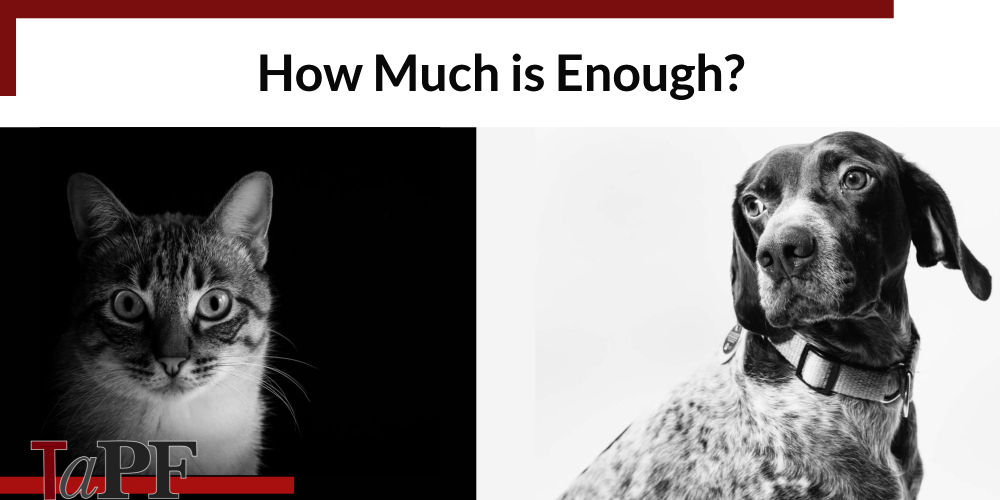Complete and Balanced pet foods in the US are required to meet AAFCO Nutrient Profiles. While it is a good thing that nutrient profiles exist, our pets certainly need all required nutrition in the proper levels – the AAFCO Nutrient Profiles are lacking in that they do not take into consideration many pets consume less calories than the existing complete and balanced nutrition system allows for.
The AAFCO Nutrient Profiles are based on a nutrients per calorie basis. As example, AAFCO Nutrient Profiles require a minimum of 45 grams of protein in adult dog foods per 1,000 kcals, and 65 grams of protein in adult cat foods per 1,000 kcals. The levels of each nutrient your pet receives from their pet food is based on how much food (kcals) they consume.
Unfortunately, the AAFCO system is one size fits all, only taking into consideration the calorie needs of active cats and dogs. But what about pets that are sedentary (couch potatoes)? Sedentary pets require less calories, but the AAFCO Complete and Balanced system is only for active pets that consume more calories – and this could be a problem.
Pets that are fed less calories a day than what the Complete and Balanced pet food requires, could be deficient in nutrients. Of significance, pets consuming less calories a day could be deficient in protein. This potential concern is NOT limited to any one style of pet food, protein deficiency can occur with dry foods, cooked foods, canned foods and raw foods – depending on how much your pet consumes each day (how my kcals of pet food they consume each day).
Thanks to pet food formulator Steve Brown, below are the minimum protein needs for cats and dogs in grams.
For Adult Cats, the minimum protein needs are:

For Adult Dogs, the minimum protein needs are:

How do you know if your pet’s food is providing this minimum protein amount?
Steve Brown to the rescue again. Steve developed a calculation to determine the amount of pet food that needs to be fed to meet minimum protein requirements.
All you need is two very basic pieces of information provided by your pet food:
- The protein percentage of your pet’s food.
Where to find it: listed in the Guaranteed Analysis. - The kcal per kilogram (kcal/kg) or kcal per pound (kcal/lb) information.
Where to find it: typically provided with the Guaranteed Analysis information or it can also be provided separately with calorie information.
With the above information, TruthaboutPetFood.com used Steve Brown’s calculations and developed an easy to use form that pet owners can enter the required information and the math is done for you.
Click Here to calculate cat food protein.
Click Here to calculate dog food protein.
A BIG thank you to Steve Brown for his help to provide pet owners this important information!
Wishing you and your pet(s) the best,
Susan Thixton
Pet Food Safety Advocate
Author Buyer Beware, Co-Author Dinner PAWsible
TruthaboutPetFood.com
Association for Truth in Pet Food

Become a member of our pet food consumer Association. Association for Truth in Pet Food is a a stakeholder organization representing the voice of pet food consumers at AAFCO and with FDA. Your membership helps representatives attend meetings and voice consumer concerns with regulatory authorities. Click Here to learn more.
What’s in Your Pet’s Food?
Is your dog or cat eating risk ingredients? Chinese imports? Petsumer Report tells the ‘rest of the story’ on over 5,000 cat foods, dog foods, and pet treats. 30 Day Satisfaction Guarantee. Click Here to preview Petsumer Report. www.PetsumerReport.com
Find Healthy Pet Foods in Your Area Click Here

The 2024 List
Susan’s List of trusted pet foods. Click Here to learn more.

The 2023 Treat List
Susan’s List of trusted pet treat manufacturers. Click Here to learn more.



























Shannon Latzke
January 31, 2024 at 1:14 pm
The problem is that NPN (non-protein nitrogen) is part of the protein content listed on the guaranteed analysis, but only ruminant animals can utilize NPN to synthesize amino acids, so this figure is not an accurate indicator of true protein.
Susan Thixton
January 31, 2024 at 1:18 pm
Without a manufacturer providing the exact formula (which isn’t going to happen), there is no way to calculate protein from meat sources to protein from plant sources. We are doing the best we can with the information we have.
paula harmata
January 31, 2024 at 1:15 pm
surprised you did not mention the amount of animal protein verses plant protein and the importance of animal protein and how kibble can have more plant protein which is not ideal
Susan Thixton
January 31, 2024 at 1:18 pm
Without a manufacturer providing the exact formula (which isn’t going to happen), there is no way to calculate protein from meat sources to protein from plant sources. We are doing the best we can with the information we have.
Paula Harmata
January 31, 2024 at 8:18 pm
No you misunderstood me or I did not communicate it correctly, what I meant was kibble manufacturers say on the front of the bag “high in protein” but in the ingredients it has so much ingredient splitting with peas, pea protein, pea isolate, pea powder and other legumes that if you add all that up, the actual protein is MORE from plant protein than animal protein at times.
Susan Thixton
February 1, 2024 at 7:40 am
I did understand your comment – but again, without knowing the exact formula of any food there would be no way to know the amount of protein from animal sources and the amount of protein from plant sources. Existing regulations allow protein from both plant and animal sources to be included as protein %.
Lane Gustafson
January 31, 2024 at 2:18 pm
Thank you so much for this information. I’ve been struggling about how much to feed my dog.